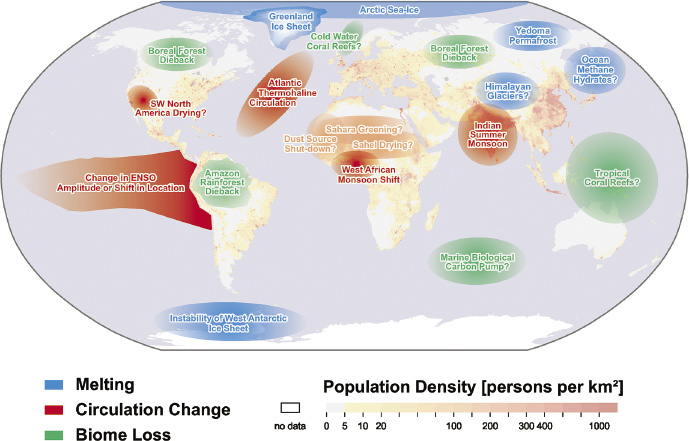- Home
- Publications
- PAGES Magazine
- Editorial: Tipping Points: Lessons From The Past For The Future
Editorial: Tipping Points: Lessons from the Past for the Future
Chris S.M. Turney, C.J. Fogwill, T.M. Lenton and R.T. Jones
Past Global Changes Magazine
24(1)
3
2016
Chris S.M. Turney1, C.J. Fogwill1, T.M. Lenton2 and R.T. Jones2
Many natural and human systems are vulnerable to long-term forcing that can push them into a different mode of operation. The “tipping points” where such abrupt changes occur are notoriously hard to predict. Looking ahead, a key problem for reducing the uncertainty in future projections is that historical records of change are too short to test the skill of the current generation of climate and environmental models, raising concerns over our ability to successfully predict abrupt change and plan for it. Published records only allow a robust reconstruction of global temperature back to 1880 and show a long-term increase of 0.85˚C. At regional scales, there have been some abrupt changes within the instrumental record. Looking further back in time, a wealth of geological, chemical and biological records capture large-scale, abrupt and often irreversible (centennial to millennial in duration) shifts in environmental and climate systems, providing an opportunity to better understand and therefore predict potential future changes.
The forcing associated with these changes in the past appears to have been relatively small, implying the existence of underlying tipping points where self-propelling change – i.e. strong, positive feedback – is triggered within the systems in question. Many regions of the world are now recognized as potentially highly-sensitive to abrupt changes caused by the passing of tipping points within different components of the climate system (Fig. 1). Some are of global significance, such as the collapse of the West Antarctic and Greenland ice sheets (leading to a sea level rise of several meters) or reorganization of the Atlantic Meridional Overturning Circulation (AMOC), and corresponding southward shift in the inter-tropical convergence zone of rainfall. Others are of more regional importance, such as the greening of the Sahara.
Innovative analyses of high-resolution records of past change suggest the climate system characteristically slowed down when a tipping point was approached. This raises the prospect that science may be able to provide society with early warning of future approaching tipping points. However, to do this successfully for inherently “slow” components of the Earth system, such as the AMOC and ice sheets, will require high-resolution paleo reconstructions of the variability of these systems in the run-up to the industrial era – providing a new motivation for PAGES' research. In addition, accurate reconstructions of the past behavior of climatic, environmental and archeological systems on quantified, absolute-dated and robust timescales provide the opportunity to better understand the underlying mechanisms and test models of future change.
This Past Global Changes Magazine describes developments in modeling past tipping points and human systems to better understand future change. Reflecting the nature of tipping points within the Earth system, the articles presented reflect a range of truly multidisciplinary research, which crosses traditional time periods or horizons. We hope the selected articles provide valuable insights into the role that tipping points play in understanding past change, and, importantly, highlight the potential of tipping points to provide lessons from the past that will help define the future.
affiliations
1Climate Change Research Centre, University of New South Wales, Australia
2Department of Geography, University of Exeter, UK
contact
Chris Turney: c.turney unsw.edu.au
unsw.edu.au
